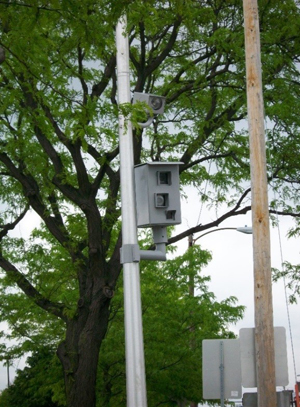InTrans / Aug 07, 2014
Green light, yellow light, red light . . . STOP!
Go! Magazine

posted on August 7, 2014
Did you know that in the United States, someone runs a red light about once every twenty minutes? Each year, more than 800 people are killed, 165,000 people are injured, and $320 billion is wasted by something completely avoidable—red-light running.
Whenever a driver enters an intersection after the light has turned red and before it turns green is considered red-light running. On the other hand, entering the intersection when the light is yellow, even if it turns red while the motorist is in the intersection, is not illegal in most places.
One proposed method of reducing and preventing this problem is red-light cameras, which were first introduced in the U.S. in the early 1980s. The exact details vary based on the manufacturer, however they all operate on the same principle: When a car enters an intersection after the light has turned red, the camera takes a photo or video of the incident. These cameras are usually angled to capture the car, the license plate, and the intersection light. Date and time stamps are also included.

“Because it is connected to the traffic controller, red-light cameras know when the light is about to turn red. If it senses that the vehicle is not going to stop for the red light, it triggers the video to start recording,” said Shauna Hallmark, director of Iowa State University’s Institute for Transportation (InTrans).
The U.S. Department of Transportation estimates that up to $50,000 per year is saved (in property damage, hospital bills, etc.) at each intersection with a red-light camera. Currently, as of 2010, 441 cities in the U.S. have installed them. In a 2005 study by the U.S. Federal Highway Administration, their research found that red-light cameras reduce dangerous right-angle crashes. In the same study, they also found there can be an increase in the number of rear-end collisions, leading to the total number of collisions remaining unchanged.
“The worst intersection crash is either head-on or ‘T-bone,’ because you are absorbing all the impact of that vehicle into your own. When people don’t run red lights, you don’t get T-bones,” said Hallmark.
Let’s explore some other common beliefs about red-light cameras.
Myth 1: Red-light cameras don’t work!
The cameras are quite effective. Although research from various universities and organizations, such as Iowa State University, the Insurance Institute for Highway Safety, and the Journal of Safety Research don’t agree on their exact effectiveness, most show that intersections with cameras see a 10-50 percent decrease in crashes. Recently, research on red-light running has been done by InTrans through their project entitled, “Red-Light Running Phase II,” which showed a 40-90 percent decrease in the number of crashes and even a notable decrease in rear-end crashes in various cities within Iowa.

Myth 2: The cameras are there to make money!
Red-light cameras are there for public safety. With any sort of decrease in the number of crashes at an intersection means there are fewer red-light runners and fewer deaths and injuries. And if fewer people are running red lights, that also means fewer tickets and less revenue.
Myth 3: Yellow lights are shortened to increase the number of red-light-runners!
The point of red-light cameras is to deter red-light running (and thereby fatalities and injuries)—not cause it. All states have minimum time limits on yellow lights, meaning cities are not legally able to shorten the time of yellow lights.
Myth 4: Cameras automatically send you a ticket!
Anything the camera picks up is reviewed by a local police officer before a decision is made on whether it was a violation or not. This helps people who are trying to turn left and get caught in the intersection or manage to squeeze through before the light changes (though in some places this is illegal).
Myth 5: I can’t argue with the ticket!
Like anything else in our legal system, drivers have a chance to argue their case in court. Drivers can acquire photos (sometimes videos) of the alleged violation, usually from the local police department.
Myth 6: It’s a violation of privacy!
Being on a public road, you have the same privacy rights as you would in a government building. That means you can, with a justifiable reason, be recorded and/or photographed while driving.
By Brandon Hallmark, Go! Staff Writer